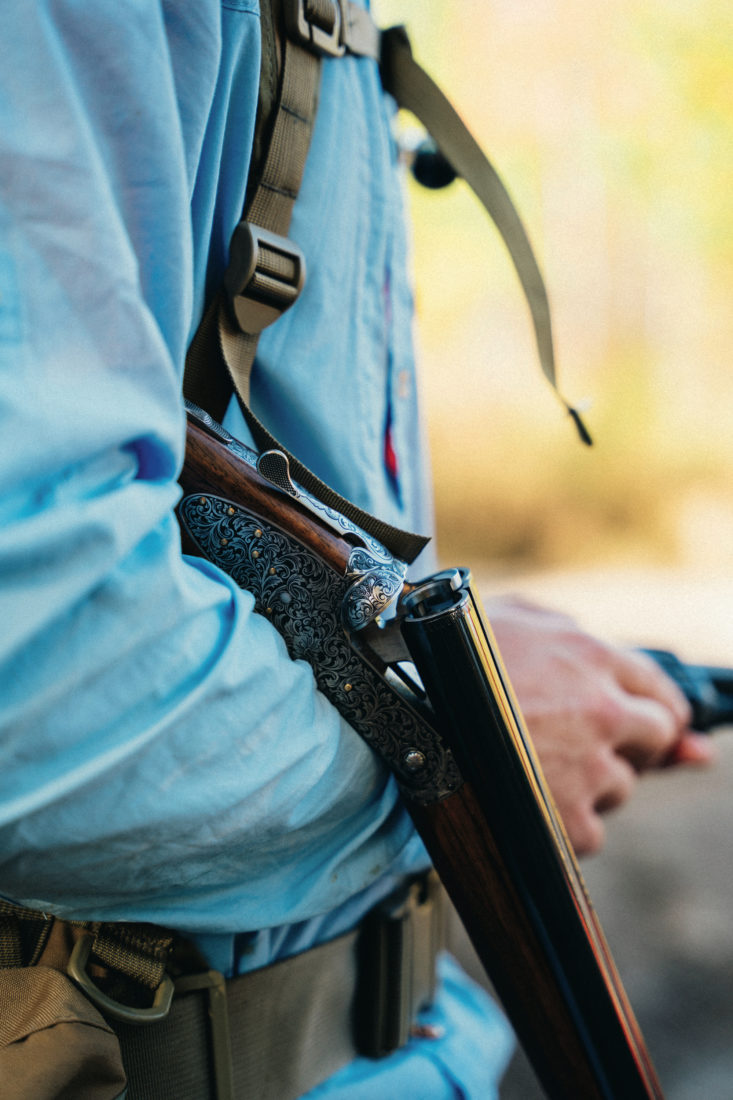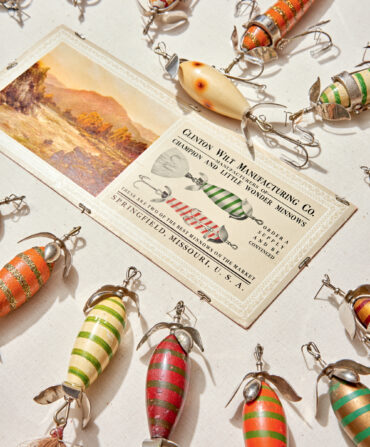I don’t know if my pal Scott Wood is ahead of his time, or just plain hardheaded. After thirty years of hunting and friendship, there’s evidence for the latter. But as for his affinity for side-by-side shotguns—he has carried a pre–World War II Belgium-made 16-gauge Francotte for decades—he explains it this way: “I like the balance of a side-by-side because it comes up quicker,” he says. “There’s a significant advantage to double triggers—I can make a split-second decision to drop back to the rear trigger if I have a long shot. And you’re looking down a wide plane over both barrels, which lends itself to true instinctive shooting. If we were meant to shoot over-and-unders, we’d have one eye on top of the other.”
In other words, Wood wields a side-by-side because it’s as functional as it is lovely, and that’s a perspective finding new traction in the field these days. There’s a genuine revival of interest in side-by-side shotguns, with manufacturers filling in the price-point gap between heavy, soulless, and correspondingly cheap models and the five-digit bespoke guns that have long defined the breed.
Part of the fuel driving the side-by-side love is the general rise in interest in upland bird hunting. It’s hard to put a number on the increase, but everyone from outfitters to gun dealers to kennel owners reports a bump in the number of people newly intrigued with chasing quail and woodcock. In addition to Wood’s list of advantages, these shotguns are trimmer and can weigh less than over-and-unders and other shotgun actions. That makes them keenly suited for pulling through the South’s more iconic landscapes—hellish cutovers, cane thickets, and briar-knotted brambles.
The newer models are also quite handsome. Whereas less expensive side-by-sides—think sub-$600—tended to be ugly and clunky, more recent offerings put greater emphasis on aesthetics and build quality.
The Fabarm Autumn is a perfect example. The Italian gunmaker began producing side-by-side shotguns at its founding around 1900, and while a few Fabarm shotguns found their way stateside, the company never gained much of an American following. That could soon change. In 2011, the venerable gunmaker Caesar Guerini announced its purchase of an equity stake in Fabarm, and last year began importing the first Fabarm side-by-side shotgun made with American shooters in mind.

The Autumn is a stunner. The case-hardened rounded action is highly colored and engraved with an ornamental scroll. Textured barrels reduce glare, and are built with a “swamp”-style rib that runs for most of its length below the height of the barrels. That helps the shooter to keep focused on the target and not the sight plane of the rib. Oil-finished deluxe-grade Turkish wood with a nice hand-fitted walnut butt plate adds a bit of flair, and helps the gun slip to the shoulder without snagging on a sleeve.
The gun’s basic design traces back to the 1970s, says Wesley Lang, president of Caesar Guerini/Fabarm/Syren, based on a four-lug locking system between the barrel and the receiver meant to handle the punishment meted out during competitive pigeon shooting. To reimagine the gun, Lang says, Fabarm moved production to modern machines, which immediately ratcheted up fit and finish. And Fabarm incorporated its modern ballistic-enhancing features, such as a choke system and Tribore barrels, which make for a tapered design that reduces weight while minimizing recoil. “We rolled the dice on this one and redrew everything for modern software and computer-aided design,” Lang says. “We’re making the same parts with much more accuracy and infinitely tighter tolerances. It’s a classic design, so you can’t change too much, but we decided to make a classic even better. If there is a side-by-side that is meant to be used and used hard, this is it.”
At present, the Autumn comes in 20-gauge only, with either twenty-eight- or thirty-inch barrels, and a single selective trigger, for a price of about $4,425. The standard model has a straight English-style grip and a classic splinter-type forend, made for cradling the gun in the hand in the traditional manner. It’s also available with an “Americanized” pistol grip and a fuller semi-beavertail forend.
While Fabarm moved to modernize a time-tested model, Upland Gun Company took a different approach. The Minnesota-based company has partnered with Italy’s R.F.M. Armi to produce semicustom shotguns on an order-by-order basis, including four side-by-side models and one over-and-under shotgun. All can be ordered online—guns are shipped to a federally licensed dealer near the customer—and are highly customizable. The entry-level gun, the Zeus, starts at $1,999. It comes in five bore sizes from .410 to 12-gauge. Buyers can select from three finishes, a half dozen barrel lengths, a flat or concave rib, three grip styles—pistol, English, and Prince of Wales—three forend styles, three checkering styles, and single or double triggers. Engraving options are practically endless. In addition to opting for ornamental scroll or deep-relief engraving, you can send in a photograph of your dog and for $800 have its likeness scribed into the sideplates or the receiver bottom. Try that with a Parker.

“The gun industry is pretty slow to change,” says Upland Gun Company’s cofounder Jerry Havel, who also owns the lauded Pineridge Grouse Camp in the big woods of Minnesota. “But these days, you can go online and build a brand-new car. We thought: Why can’t we do that with an upland gun?”
The process is straightforward: Once customers create a gun on the company’s website, a representative calls them to go over the quote. “We talk to every buyer,” Havel says. “You say you’re a grouse hunter and want modified and full chokes. Are you sure about that?” Customers can select wood grades based on photographs sent from the factory in Italy, and get a custom stock from a trained gun fitter’s measurements. Upgrades boost cost, yes, but a gorgeous Zeus can be yours for less than many used continental or early-twentieth-century American side-by-sides. And there are three other model lines from which to choose.
If you’re looking for an upland gun that leaves a bit more change in your pocket for shotgun shells, CZ has a great option. Built in the Czech Republic company’s Missouri plant, the CZ Bobwhite G2 Project Upland side-by-side is an upgrade of CZ’s popular Bobwhite model, with tweaks based on thousands of votes from followers of Project Upland, a wildly popular multimedia company that produces upland hunting content. The new models come with a handsome color-case finish, decorative sideplates, a nicer select-grade Turkish walnut stock with an English straight grip, double triggers, and a splinter forend. It’s available in 12-, 20-, and 28-gauge platforms, all with choke tubes, with prices at $1,565 to $1,699, depending on gauge.
Voting for a democratically designed shotgun—there’s not much that’s more American than that.








